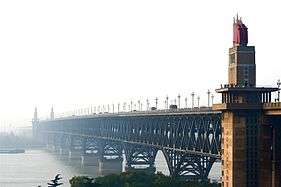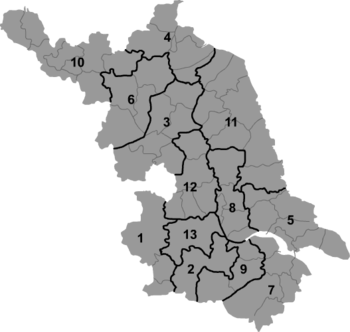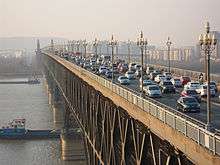Nanjing Yangtze River Bridge
| Nanjing Yangtze River Bridge 南京长江大桥 | |
|---|---|
 | |
| Coordinates | 32°06′55″N 118°44′20″E / 32.1152°N 118.7388°ECoordinates: 32°06′55″N 118°44′20″E / 32.1152°N 118.7388°E |
| Carries |
|
| Crosses | Yangtze River |
| Locale |
|
| Owner |
People's Government of Nanjing Shanghai Railway Bureau |
| Characteristics | |
| Design | Double-decked truss bridge |
| Material | Steel |
| Total length |
Main Bridge: 1,576 metres (5,171 ft) Highway: 4,588 metres (15,052 ft) Railway: 6,772 metres (22,218 ft) |
| Width |
Highway Bridge: 19.5 metres (64 ft) (with 4.5 metres (15 ft) pedestrian path) Railway: 14 metres (46 ft) |
| Height | 70 metres (230 ft) |
| Longest span | 160 metres (525 ft) |
| No. of spans | 10 |
| Piers in water | 9 |
| Clearance below | 24 metres (79 ft) |
| History | |
| Designer | Ministry of Railways |
| Construction start | 18 January 1960 |
| Construction end |
Railway: 30 September 1968 Highway: 29 December 1968 |
| Replaces | Yangtze River Railway Ferry |
| Statistics | |
| Daily traffic |
80,000 vehicles 200 pairs of trains (2011) |
 Nanjing Yangtze River Bridge Location in Jiangsu | |
The Nanjing Yangtze River Bridge (Chinese: 南京长江大桥; pinyin: Nánjīng Chángjiāng Dàqiáo) is a double-decked road-rail truss bridge across the Yangtze River between Pukou and Xiaguan in Nanjing, China. Its upper deck is part of China National Highway 104, spanning 4,588 metres (15,052 ft). Its lower deck, with a double-track railway, is 6,772 metres (22,218 ft) long, and completes the Beijing-Shanghai Railway, which had been divided by the Yangtze for decades. Its right bridge consists of nine piers, with the maximum span of 160 metres (525 ft) and the total length of 1,576 metres (5,171 ft). The bridge carries approximately 80,000 vehicles and 190 trains per day.
The bridge was completed and open for traffic in 1968. It was the third bridge over the Yangtze after the Wuhan Yangtze River Bridge and the Chongqing Baishatuo Yangtze River Bridge. It was the first heavy bridge designed and built using Chinese expertise.
Suicide site
According to state media, the Nanjing Yangtze River Bridge surpassed the Golden Gate Bridge as the most frequent suicide site in the world, with more than 2,000 suicides estimated by 2006.[1]
Gallery
 Vehicles on the bridge
Vehicles on the bridge- Statue of first Yangtze river bridge at Nanjing
- Scenery on the river
 Nanjing Yangtze River Bridge seen from the upstream right bank
Nanjing Yangtze River Bridge seen from the upstream right bank- Perspective of the double-column frame piers of the railway bridge approach structure
 Shot in 2014
Shot in 2014
See also
| Wikimedia Commons has media related to Nanjing Yangtze River Bridge. |
- Dashengguan Yangtze River Bridge Nanjing's other railway bridge that carries the Beijing–Shanghai High-Speed Railway.
- Yangtze River bridges and tunnels
- Beijing–Shanghai Railway
- Rail transport in China
- Passenger rail transport in China
References
- Notes
- ↑ Sun Xiaoyu (September 28, 2006). :zh=2000自杀者为何选择南京长江大桥? [Why have 2,000 people killed themselves at the Nanjing Yangtze River Bridge?]. People's Daily (in Chinese). Retrieved January 12, 2015.
- Bibliography
- Gao Mobo (2008). The Battle for China's Past: Mao and the Cultural Revolution. Pluto Press: Verso. ISBN 978-0-7453-2780-8.
